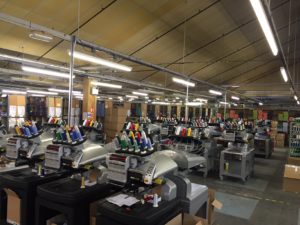
This month managing director of Amaya Sales UK, Peter Wright, talks through how embroidery has changed over the last three decades and what changes he will believe will take place in the future.
I have been involved in the embroidery business now for over 30 years now. Over those years I have seen so many changes; but it’s hard to imagine what’s around the corner.
Over 30 years ago, the mechanical machines were controlled by a jacquard reader which in turn moved the frame system to transmit the design on to the garment or material. The next stage was through a paper tape system and then moved on to direct connection with networking and Ethernet. Over the years, these transformations sped up the route for supplying the design on to the machine. Machines also got faster, the mechanical machines only stitched at around 400/500 stitches per minute. Now some machines are up to 1,500 stitches every minute without any detriment to quality.
I believe that one area that could be improved in a lot of cases is the efficiency and organisation of the production. This is just as important as machine speed.
Just as the machine side has improved the organisational side, in some companies, could be improved dramatically.
Some of the larger companies have realised that not being efficient has been costing them dearly with regards to getting goods out of the door. This has become more apparent in the last few years because of smaller orders and more personalisation. With these types of orders you need to be switched on to the best way of dealing with them.
The ideal situation is that all the machine operator has to do is load the garment, load the design information and press start. If they have to get involved with other factors then production will probably suffer. Try and allow your operator to produce the maximum possible and prevent as much downtime as possible.
Machine downtime is what will cost you money and lost production
Some of the better embroidery software can benefit you by offering a faster delivery of the design to the machines. The colour set up can be saved with the design on to the work sheet and the full information can be saved to a bar code. All the operator has to do is read the code with the bar code reader and all the information is sent to the machine. This saves the time taken by the operator to input all the colour changes.
Some embroidery machine operating software have name dropping systems which allow for different names to be downloaded automatically. Just load up all the names and when one has finished embroidering the next one loads.
Also with smaller orders there is a need for changing cones of thread, this can take up quite a lot of time, so a modular machine system would help greatly in this case. On a modular system, you would re-thread on head and then start it, then go on to the next and so on. On a fixed head machine, you would have to wait until all the heads are threaded before starting. The saving on this alone is massive and if you add on the time taken for thread breaks, bobbin changes etc. then changing to a modular system would save you money and decrease you turn around times.
It’s also worth looking at some of the order taking systems around, some of them work in conjunction with you wed site.
Some embroidery machine manufacturers have added automatic thread tensioning, more speed and more needles, but I cannot see any other great changes coming on the machine side in the near future.
So, what I am saying is that most of the important improvements will be in streamlining your production and making it more efficient. Your customers require the best turnaround possible so don’t let your competitors take them away.
 Printwear & Promotion The Total Promotional Package
Printwear & Promotion The Total Promotional Package




